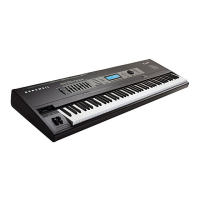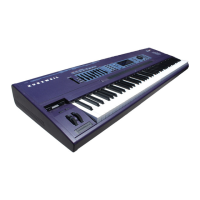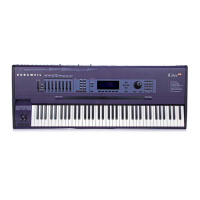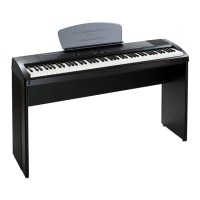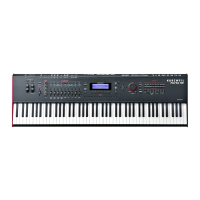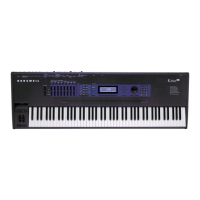7-18
Setup Mode
The BEND Page
Most programs respond to pan messages on the next keystrike. This means that if you hold a note
and change the pan, the current note will stay at its current position until you strike it again.
However, a PC3A program that uses the PANNER algorithm will respond to real-time pan
adjustments as well.
The BEND Page
The parameters on the BEND page dene the bend ranges for each of the three types of pitch
bend messages the PC3A can respond to.
Parameter Range of Values Default
Bend Range Up (semitones) Prog, 0 to 127 semitones 2
Bend Range Up (cents) Prog, 100 cents 0
Bend Range Down (semitones) Prog, 0 to 127 semitones 2
Bend Range Down (cents) Prog, 100 cents 0
Aux Bend 1 Up 0 to 60 semitones 12
Aux Bend 1 Down 0 to 60 semitones 12
Aux Bend 2 Range 0 to 60 semitones 2
Bend Range (Semitones) and Bend Range (Cents): Up and Down
BendRangeUp(ST) and BendRangeDown(ST) sends a bend range message to an internal
program or a MIDI device, telling it how to dene subsequent pitch bend messages. Some
programs may behave strangely when you change the Bend Range value, because they use FUNs
or DSP Functions to aect the pitch wheel. In that case, you should either set the value of Bend
Range to Prog, or edit the program itself.
NOTE:ThesettingsforBendRangeUpandDownareonlyreectedinSetupmode.Evenifyouspecify
BendRangeUpandDownvaluesforthecontrolsetup(setupassignmentswhicharespeciedinSetup
modeandusedinProgrammode,)bendrangevalueswillnotbereectedinanymodeexceptSetupmode,
andpitchbendmessagesinthecurrentprogram(inProgrammode)willresultinbehaviorasspeciedfor
the Pitch Bend Range parameters on the COMMON page in the Program Editor.
BendRangeUp(ct) and BendRangeDown(ct) lets you ne tune the value for Bend Range
(semitones). 100 cents equals one semitone, or one half-step; you can set this parameter
anywhere between 0 and 100 cents.

